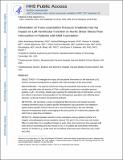| dc.contributor.author | Staziaki, Pedro Vinícius | |
| dc.contributor.author | Ghoshhajra, Brian | |
| dc.contributor.author | Bhatt, Ami B. | |
| dc.contributor.author | Keshavarz Motamed, Zahra | |
| dc.contributor.author | Rikhtegar Nezami, Farhad | |
| dc.contributor.author | Partida, Ramon | |
| dc.contributor.author | Nakamura, Kenta | |
| dc.contributor.author | Ben Assa, Eyal Benjamin | |
| dc.contributor.author | Edelman, Elazer R | |
| dc.date.accessioned | 2017-12-14T21:01:33Z | |
| dc.date.available | 2017-12-14T21:01:33Z | |
| dc.date.issued | 2016-09 | |
| dc.date.submitted | 2016-06 | |
| dc.identifier.issn | 1936-8798 | |
| dc.identifier.uri | http://hdl.handle.net/1721.1/112766 | |
| dc.description.abstract | Objectives: This study sought to investigate the impact of transcatheter intervention on left ventricular function and aortic hemodynamics in patients with mild coarctation of the aorta (COA). Background: The optimal method and timing of transcatheter intervention for COA remains unclear, especially when the severity of COA is mild (peak-to-peak transcoarctation pressure gradient < 20 mm Hg). Debate rages regarding the risk/benefit ratio of intervention versus long-term effects of persistent minimal gradient in this heterogeneous population with differing blood pressures, ventricular function, and peripheral perfusion. Methods: We developed a unique computational fluid dynamics and lumped parameter modeling framework based on patient-specific hemodynamic input parameters and validated it against patient-specific clinical outcomes (before and after intervention). We used clinically measured hemodynamic metrics and imaging of the aorta and the left ventricle in 34 patients with mild COA to make these correlations. Results: Despite dramatic reduction in the transcoarctation pressure gradient (catheter and Doppler echocardiography pressure gradients reduced by 75% and 47.3%, respectively), there was only modest effect on aortic flow and no significant impact on aortic shear stress (the maximum time-averaged wall shear stress in descending aorta was reduced 5.1%). In no patient did transcatheter intervention improve left ventricular function (e.g., stroke work and normalized stroke work were reduced by only 4.48% and 3.9%, respectively). Conclusions: Transcatheter intervention that successfully relieves mild COA pressure gradients does not translate to decreased myocardial strain. The effects of the intervention were determined to the greatest degree by ventricular–vascular coupling hemodynamics and provide a novel valuable mechanism to evaluate patients with COA that may influence clinical practice. Key Words: aortic hemodynamics, left ventricle function, mild coarctation, peak-to-peak pressure gradient, transcatheter intervention | en_US |
| dc.description.sponsorship | National Institute of Mental Health (U.S.) (R01 GM 49039) | en_US |
| dc.description.sponsorship | American Heart Association (Postdoctoral Fellowship 16POST26420039) | en_US |
| dc.publisher | Elsevier BV | en_US |
| dc.relation.isversionof | http://dx.doi.org/10.1016/J.JCIN.2016.06.054 | en_US |
| dc.rights | Creative Commons Attribution-NonCommercial-NoDerivs License | en_US |
| dc.rights.uri | http://creativecommons.org/licenses/by-nc-nd/4.0/ | en_US |
| dc.source | PMC | en_US |
| dc.title | Elimination of Transcoarctation Pressure Gradients Has No Impact on Left Ventricular Function or Aortic Shear Stress After Intervention in Patients With Mild Coarctation | en_US |
| dc.type | Article | en_US |
| dc.identifier.citation | Keshavarz-Motamed, Zahra, et al. “Elimination of Transcoarctation Pressure Gradients Has No Impact on Left Ventricular Function or Aortic Shear Stress After Intervention in Patients With Mild Coarctation.” JACC: Cardiovascular Interventions, vol. 9, no. 18, Sept. 2016, pp. 1953–65. | en_US |
| dc.contributor.department | Massachusetts Institute of Technology. Institute for Medical Engineering & Science | en_US |
| dc.contributor.department | Harvard University--MIT Division of Health Sciences and Technology | en_US |
| dc.contributor.mitauthor | Keshavarz Motamed, Zahra | |
| dc.contributor.mitauthor | Rikhtegar Nezami, Farhad | |
| dc.contributor.mitauthor | Partida, Ramon | |
| dc.contributor.mitauthor | Nakamura, Kenta | |
| dc.contributor.mitauthor | Ben Assa, Eyal Benjamin | |
| dc.contributor.mitauthor | Edelman, Elazer R | |
| dc.relation.journal | JACC: Cardiovascular Interventions | en_US |
| dc.eprint.version | Author's final manuscript | en_US |
| dc.type.uri | http://purl.org/eprint/type/JournalArticle | en_US |
| eprint.status | http://purl.org/eprint/status/PeerReviewed | en_US |
| dc.date.updated | 2017-12-14T18:50:17Z | |
| dspace.orderedauthors | Keshavarz-Motamed, Zahra; Rikhtegar Nezami, Farhad; Partida, Ramon A.; Nakamura, Kenta; Staziaki, Pedro Vinícius; Ben-Assa, Eyal; Ghoshhajra, Brian; Bhatt, Ami B.; Edelman, Elazer R. | en_US |
| dspace.embargo.terms | N | en_US |
| dc.identifier.orcid | https://orcid.org/0000-0001-5853-3887 | |
| dc.identifier.orcid | https://orcid.org/0000-0002-4210-3177 | |
| dc.identifier.orcid | https://orcid.org/0000-0002-8424-8040 | |
| dc.identifier.orcid | https://orcid.org/0000-0002-9209-597X | |
| dc.identifier.orcid | https://orcid.org/0000-0002-9129-7000 | |
| dc.identifier.orcid | https://orcid.org/0000-0002-7832-7156 | |
| mit.license | PUBLISHER_CC | en_US |

